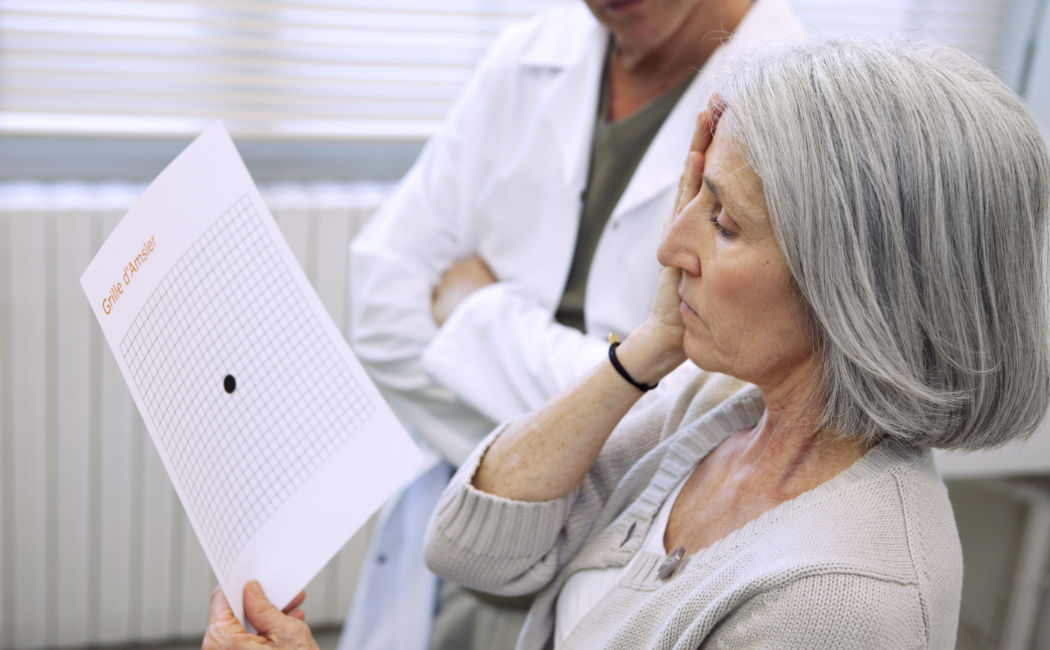
Age-Related Macular Degeneration (ARDM)
It is a slow illness caused by degeneration, damages or deterioration of the macula, which is the part of the retina that allows the eye to perceive small and thin objects.
There are two types of ARDM:
- DRY ARDM, the most frequent one (90%). It occurs when YELLOW COLORED DEPOSITS, called drusen, accumulate in the macula, SLOWLY DAMAGING the macular cells, causing visual distorsion in the affected eye and a blurry stain in the center of the vision.
- HUMID ARDM (10%). It is originated when SMALL BLOOD VESSELS ARE FORMED IN AN ABNORMAL WAY IN THE MACULA. These vessels are very fragile and they lose blood and fluids that damage the macular cells. It is the most serious type and can cause a total loss of the central vision.
What symptoms does it produce?
Initially it affects only one of the eyes, but with time the disease usually affects both. Its symptoms are blurred central vision, difficulty in undertaking tasks requiring detailed vision (reading, sewing, driving, etc.). Straight lines are perceived as twisted, sloping or incomplete. In its latter stages, a black spot covers the entire central area of the gaze.
What factors give rise to ARMD?
Age and Sex.Age is the main factor for developing ARMD. The incidence of initial ARMD in people over the age of 55 is estimated to be around 10%. In the over-75 age group, the figure shoots up to around 30%. Women are more susceptible to this disease than men.
- Eating Habits.Macula cells are highly sensitive to molecules known as free radicals. Current research shows that people whose diet is poor in antioxidants have more risk of suffering from ARMD. Other factors that have an influence on higher free-radical levels in our organism are alcohol and foods rich in cholesterol and saturated fats.
- Smoking.Smoking reduces the eye's antioxidant levels and doubles the risk of suffering from ARMD.
- Sunlight.Macula cells are highly susceptible to being damaged by sunlight. Fair-skinned people with light-coloured eyes and those with high exposure to ultraviolet light are more at risk of ARMD.
- Other Factors.There are other influential factors such as inheritance, blood pressure, etc.
How is it treated?
Nowadays there is no curative process for ARDM. All present therapeutic measures are directed to stop the advance of the illness.
In the case of DRY ARDM it is recommended to carry out frequent check out with the ophthalmologist to detect prematurely an evolution towards the humid type. Other measures include initiating a vasodilator treatment, antioxidant drugs, etc.
In case of humid ARDM the treatments focus on stopping the progression of the illness, but they rarely give back the already lost vision. They include:
- FLUORESCENIC ANGIOGRAPHY. A contrast in vein is introduced that to arrive to eye permits us to detect the locating of the points that liquids in the blemish are fleeing.
- LASER THERAPY. Once the leaking points are located they are sealed with laser. It is a painless technique.
- FOTODINAMIC THERAPY. It consists on the introduction by vein of an initially inactive drug that fills the anomalous vessels of the macula. Subsequently the laser is applied, which activates the drug only sealing these vessels, without damaging the adjacent healthy cells.
Currently other therapeutic alternatives are being investigated among them are surgery with intravitreal triaminolona, anecortave, lucentis…
You will be properly inform about all of them in Marcos Ocular Institute.
